Maria Concepcion V. Roxas
Writer/Transcriber
Baruch Ministry
Cambridge Dictionary defines “coming to the roots” as finding meaning in the beginning: how everything started. As stated in Colossians 2:7: “Have your roots in Him; build yourselves up in Him; grow strong in what you believe and more thankful than ever before.” This phrase was conspicuously posted at the front of our pilgrims’ bus, a reminder of our Christian beginnings. Indeed, the pilgrimage to the Holy Land was a two-week spiritual sojourn (Nov.16-29) which commenced from Jordan to Israel and finally to Egypt tracing our spiritual roots, i.e., coming from God and eventually returning to Him.
‘A LIFELONG EXPERIENCE TO DEEPEN OUR FAITH’ was how the ten (10) member-delegation of the Lords Flock Catholic Charismatic Community described the Holy Land Pilgrimage. The TLF members who have been blessed to experience this spiritual sojourn are Sisters Malou Bague (the able and gracious tour group lead), Resurecion Pichay, Carmen Delobrino, Eleonor Caragan, Linda Oliveros, Misella Repuyan, Jen Sanorjo, Connie Roxas, Maria Vera Tuplano; and the brother: Eghai Roxas. A group of 28 pilgrims also joined the TLF group, together with Pilgrims’ Chaplain Fr. Alrich Gamboa, OSJ.
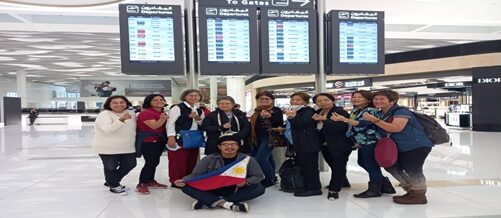
Our arrival at Bahrain International Airport from NAIA 1- Manila are LF sisters (L-R): Connie Roxas, Jen Sanorjo, Resurecion C. Pichay, Misella Repuyan, Eleonor M. Caragan, Maria Vera Tuplano, Carmen Delobrino, Linda Oliveros, and Malou U. Bague; with lone brother, Eghai Roxas (C) holding the Philippine flag.
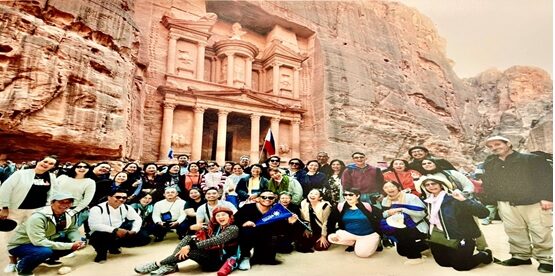
At the Treasury Hall of Petra, Jordan are the 38 pilgrims with Chaplain Fr. Alrich Gamboa, OSJ (left in sunglass and white shirt).
As Pilgrims, we walked and visited a site/church each day. We consistently prayed the rosary and attended the holy mass daily, officiated by Fr Alrich. Each conversation, encounter whether good or bad, new or old, acted as stimulus towards further spiritual reflections and dialogues. They were stepping stones to understand and fortify our faith- in Jesus Christ, the God who has come in search for everyone.
Quite a hectic 14-day schedule, we flew to three (3) international airports including transfers, crossed borders (from Jericho, Jordan to Qumran, Israel; Dahab to Taba border, Egypt; and Dahab to Cairo, Egypt) then moved to five (5) hotels. Most importantly, we visited the sacred sites/churches where we truly experienced the presence of our Lord Jesus, Mama Mary and all the Apostles who lived there. Moreover, our sojourn also included salient sacred sites which pertain to our salvation history as accounted below.
JORDAN
Baptism Site (Qasr Al Yahud), Jordan River Valley
Qasr al-Yahud (means ‘the tower of the Jews’ in Arabic and known as Al-Maghtas in Hebrew), is in the western section of the traditional site of the baptism of Jesus by John the Baptist on the Jordan River (Matthew 3:13-17). It has also been traditionally identified with two episodes from the Hebrew Bible, as one of the possible points through which the Israelites have crossed the Jordan river as they reached the Promised Land (Joshua 3). It is also the site where prophet Elijah ascended to heaven (2 Kings 2:1-14).
Zacchaeus and the Sycamore Tree (The tree of life)
In the account, Jesus was passing through Jericho on his way to Jerusalem. He saw Zacchaeus, a wealthy tax collector who was hated by the Jews because he cheated them out of their money. He was short in stature and so was unable to see Jesus through the crowd. He ran ahead and climbed a sycamore tree along Jesus’s path (Luke 19:1-10). At that time, it was shameful for a grown man to climb a tree, yet Zacchaeus did not mind being mocked if it meant seeing Jesus.
The Sycamore Tree symbolizes regeneration, a reference to someone who is spiritually reborn. Zacchaeus’ regenerated heart caused him to make restitution and change his life in Jericho.
The Mount of Temptation, Jericho
Known as Mount Quruntul in Arabic and Jabal al-Qurunṭul, this is the official present name of the mountain. It sits 350 meters (1,150 feet) above sea level in the middle of a desert extending between Jerusalem, Jericho and the Jordan River. Jesus allegedly went off to this mountain to pray and was tempted by the devil. The three (3) temptations were: “stones into bread” (John 6:26-31); “jump from the temple”: (John 2:18); and “kingdoms of the world” (John 6:15).
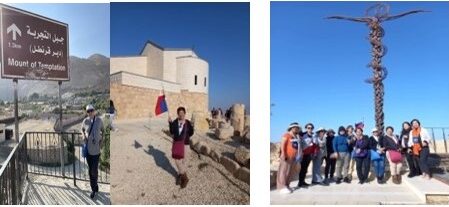
Sis Connie Roxas standing by the signage and Sis Malou Bague carrying the Phi.l flag by the entrance; and the Lord’s Flock group in front of the big Cross of the Mount.
Dead Sea and its Scrolls
The Dead Sea is referred in the Bible as the “Salt Sea” and has also been called the Sea of Sodom, the Sea of Lot and the Stinking Sea because of the rotten egg odor created by the Sulphur in the water (Chronicles 2: 20).
As told, the Dead Sea Scrolls (also the Qumran Caves Scrolls) are ancient Jewish and Hebrew religious manuscripts discovered in 1946 at the Qumran Caves in what was then Mandatory Palestine, near Ein Feshkha in the West Bank, on the northern shore of the Dead Sea.
The scrolls date back so closely to the time of Christ. They are all the more solidified as honest records of the Hebrew Bible, and written in three different languages: Hebrew, Aramaic, and Greek.
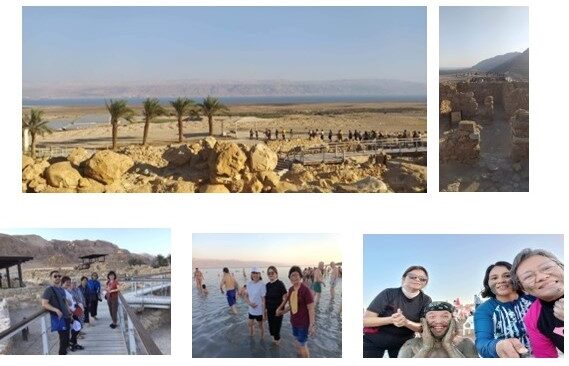
Pilgrims lined up in the lowest part of the Dead Sea as they pass through the Scrolls and
Testing the Sulphur salt at the Dead Sea (good for the skin) by some of the pilgrims.
ISRAEL
Wedding Church, Cana/ Transformation of Water into Wine
The miracle is told in John 2:1-11: Jesus, His mother, and His disciples attended a wedding in the village of Cana. When the wine ran out at the feast, Jesus turned water into wine, thus demonstrating His divinity to His disciples.
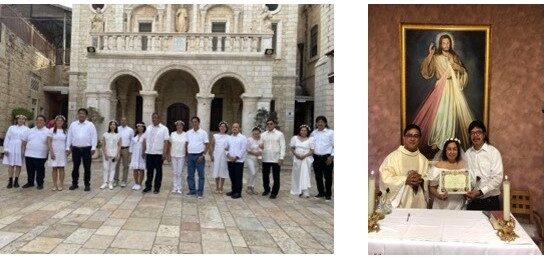
Among the eight pilgrim couples, LF was represented by Bro Eghai & Sis Connie Roxas.
Church of the Annunciation & Mary’s Well, Nazareth
The Church commemorates the place where the angel Gabriel visited Mary and delivered the invitation for her to bear God’s Son (Gospels of Matthew and Luke).
Found just below the Greek Orthodox Church of the Annunciation in modern-day Nazareth, the Well was positioned over an underground spring that served for centuries as a local watering hole for the Palestinian villagers. Renovated twice, in 1967 and in 2000, the current structure is a symbolic representation of the structure that was once in use.
Yardenit: Baptismal site by the Jordan River
According to Christian tradition, the baptism of Jesus (Matthew 3:13-17) took place in Bethany Beyond the Jordan (Al-Maghtas), north of the Dead Sea and east of Jericho. For centuries, al-Maghtas was the most important baptism site for pilgrims, and monasteries and guest-houses were established near it. Today in Jordan, Al-Maghtas shows early religious structures connected with baptism or religious baths.
Since the Six-Day War, Israel has occupied the west margin of the Jordan river, including the area immediately opposite the Jordanian site, known as Qasr al-Yahud. However, the Israeli Ministry of Tourism established Yardenit in 1981 as an alternative pilgrimage site. Yardenit became the first regulated baptism site in Israel. It attracted pilgrims and a visitor center was built.

With Sis. Eleonor Caragan in the middle with 2 others, Sisters Resie Pichay, Vera Tuplano, Carmen Delobrino, Misella Repuyan and Linda Oliveros.
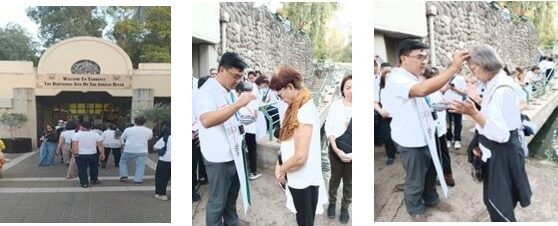
The entrance to Yardenit with Chaplain Fr. Aldrich Gamboa baptizing Sisters Eleonor and Resie.
Mount of Beatitudes, site where Jesus uttered the immortal words
The Sermon on the Mount (recorded in Matthew 5-7) is by far the most famous speech of Jesus. He delivered it on a hill north of the Sea of Galilee, which was later named ‘Mount of Beatitudes’ to commemorate these events. This site, very near Tabgha and also known as Mount Eremos, has been commemorated for more than 1600 years.
Church of the Nativity, Bethlehem (Christ birth)
The inscribed property is situated 10 km. south of Jerusalem on the site identified by Christian tradition as the birthplace of Jesus since the 2nd century. A church was first completed there in A.D. 339 and the edifice that replaced it after a fire in the 6th century has retained elaborate floor mosaics from the original building. The site also includes Latin, Greek Orthodox, Franciscan and Armenian convents and churches, as well as bell towers, terraced gardens and a pilgrimage route.
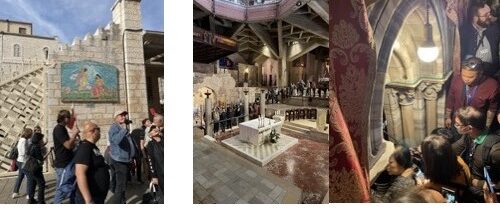
Views of the Entry, Main Altar and the Main Crypt at the Basement of the sacred place.
Lion’s Gate, Old City of Jerusalem
The Lions’ Gate, called St Stephen’s Gate, starts the traditional Christian observance of the last walk of Jesus from prison to crucifixion. Carved into the wall above the gate are four lions, two on the left and two on the right. Suleiman the Magnificent had the carvings made to celebrate the Ottoman defeat of the Mamluks in 1517. Legend has it that Suleiman’s predecessor Selim I dreamed of lions that were going to eat him because of his plans to level the city. He was spared only after promising to protect the city by building a wall around it. This led to the lion becoming the heraldic symbol of Jerusalem.
The Stations of the Cross at Via Dolorosa Street
Via Dolorosa, also known as Way of the Cross is situated in the Old City of Jerusalem. It is the route that traditionally traces the steps of Jesus Christ on the way to Golgotha, the place of His crucifixion, burial and resurrection.
Via Dolorosa is a numbered trail that winds through the Old City, marking locations of significant moments during Jesus’ journey bearing the cross He was crucified on. It begins in the Muslim Quarter and ends in the Christian Quarter, and pilgrims frequently kneel in prayer at different stations. The Church of the Holy Sepulcher is also where the final stations of the crucifixion, burial and resurrection of Jesus.
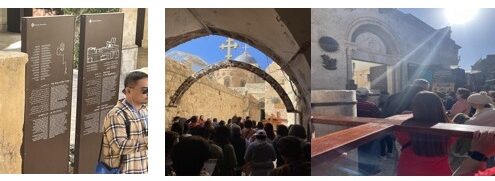
As pilgrims, we were made to carry our crosses in each of the Stations of the Cross.
Pater Noster Church, where Jesus taught his disciples the ‘Our Father’
The Church of the Pater Noster is a Roman Catholic church located on one of the summits of Mount of Olives in Jerusalem. By current Christian tradition, it is the site where Jesus taught his disciples “The Lord’s Prayer.”
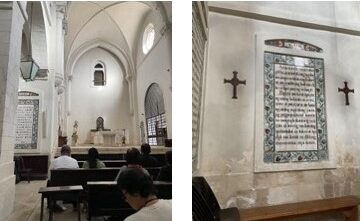
Inscribed on the wall is the ‘Our Father’ in Tagalog version.
Last Supper’s Room and the Tomb of King David in Mount Zion
Located on an upper floor of King David’s Tomb, the Room of the Last Supper, also called the Cenacle, is considered one of the holiest sites for Christianity in Jerusalem, since according to the tradition, it was the place where the last supper took place.
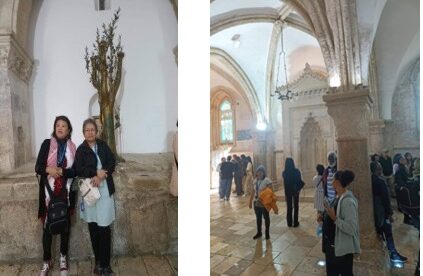
Sisters Jen Sanorjo and Misella Rapuyan posing at the back of the tree and
the Upper Room or Cenacle of the Last Supper.
The Western Wall, Old City of Jerusalem
Known as the most holy site in the Jewish faith, it is the last remnant of the original retaining wall which surrounded the Second Temple, which was built over 2,000 years ago.

Views of the different denomination of pilgrims in the Western Wall.
In Ephesians 2:17-22, the body of Christ is described like the walls of a temple, ‘built on the foundation of the apostles and prophets, with Christ Jesus Himself as the cornerstone’ (verse 20). We are all part of the wall that ‘grows into a holy sanctuary in the Lord’ (verse 21).
The wall was originally erected as part of the expansion of the Second Jewish Temple begun by Herod the Great, which resulted in the encasement of the natural, steep hill known to Jews and Christians as the Temple Mount, in a huge rectangular structure topped by a flat platform, thus creating more space for the Temple.
EGYPT
Mount Sinai and St. Catherine’s Monastery, Dahab
Mount Sinai or Mount Moses is located on the Sinai Peninsula of Egypt. It is the traditional site where Moses received the Ten Commandments from God. It is 2285 meters high. It takes about 3 hours to climb the 7,498-foot peak following the Path of Moses, a stairway of nearly 4,000 steps.
It is also the site where the burning bush went on fire, but was not consumed by the flames. When Moses beheld the burning bush, God (or Yahweh) spoke to Moses and told him to lead the Israelites out of Egypt and into Canaan (Exodus19: 3-4). They were at this mountain because God saved them from slavery in Egypt. God’s next act changed them into a unique people with a unique purpose by entering into a covenant with them.
Following the peace agreement reached between Egypt and Israel in 1979, the Sinai Peninsula was returned to Egypt and demilitarized.
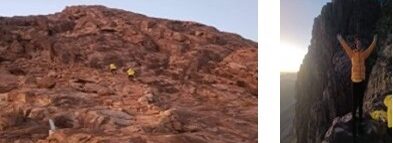
View of Mt Sinai as two of the pilgrims tried to climb it while Sis Jen Sanorjo was raising her hands up as she was able to get to the St. Catherine monastery.
Burning Bush of God in Saint Catherine Monastery
The burning bush is the location at which Moses was appointed by Yahweh (God) to lead the Israelites out of Egypt and into Canaan (Exodus19: 3-4). The bush is situated at St. Catherine’s Monastery, Sinai, which monastic tradition identifies it as being the burning bush.
Saint Catherine grew devoted to Christ and wanted to take on the suffering of the entire world, secretly mortifying her flesh and fasting for days. She was tortured on a wheel by the Emperor Maxentius for refusing to renounce her Christian faith. During her subsequent torture, she professed that she had consecrated her virginity to Jesus Christ, her spouse, and was sentenced to death. The wheel broke and Catherine was eventually beheaded instead. Her martyrdom is remembered in the firework called the ‘Catherine Wheel’.
Saint Catherine is the patroness of fire protection because her sister saw her deep in prayer in the kitchen, engulfed in flames from the stove.
Saint Simon Monastery & Cave Church, Cairo
Simon the Tanner, was a craftsman who lived during the 10th century, and the cave church that was dedicated to him. Using a pre-existing cave and the slope that led into it, the current monastery seats 20,000 people around a central pulpit. Other nearby caves have also been built into separate church spaces, and all of them have been linked to create a massive Christian complex in the heart of garbage city.
One of the more populous groups is the garbage-scavenging Zabbaleen, who have retained their Coptic beliefs and established the largest Christian church in the Middle East at the Monastery of St. Simon.
The Zabbaleen (meaning literally “garbage people”) village at the base of the Mokattam cliffs began around 1969 when the Cairo governor decided to move all of the garbage collectors to a single settlement. The garbage collectors were largely Coptic Christians, and as their numbers continued to grow over the years the need for a centralized church began to grow. In 1975 the first Christian church was built in the village, but after a large fire broke out nearby, work began on a monastery that was built right into the cliff-side.
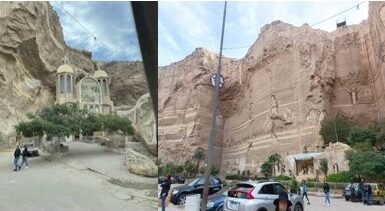
The Church etched by the Mountain while the LF sisters pose in front of the Altar.
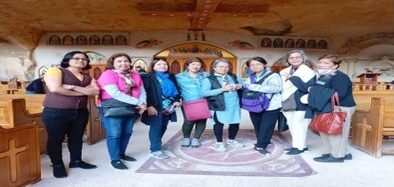
The Great Pyramids of Giza
The pyramids of Giza were royal tombs built for three different pharaohs. The northernmost and oldest pyramid of the group was built for Khufu (Greek: Cheops), the second king of the 4th dynasty. All three of Giza’s famed pyramids and their elaborate burial complexes were built during a frenetic period of construction, from roughly 2550 to 2490 B.C. The pharaoh’s final resting place was usually within a subterranean burial chamber underneath, the pyramid. Although the Great Pyramid has subterranean chambers, they were never completed, and Khufu’s sarcophagus rests in the King’s Chamber, where Napoleon was said to have sojourned, deep inside the Great Pyramid.
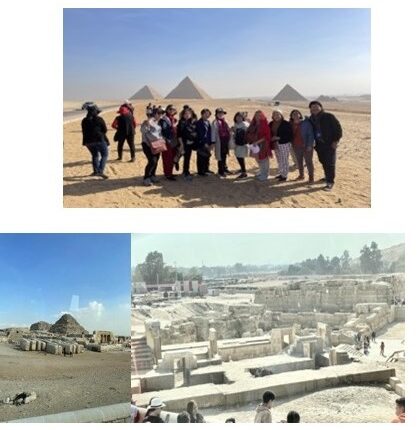
The National Museum of Egyptian Civilization (NMEC), Cairo
It is a large museum (490,000 square meters (5,300,000 sq ft) in the ancient city of Fustat, now part of Cairo, Egypt. The museum partially opened in February 2017 and displayed a collection of 50,000 artefacts, presenting Egyptian civilization from prehistoric times to the present day.
The permanent collection is divided into two separate regions, one chronological, the other thematic. The thematic areas included the following: Dawn of Civilization, The Nile, Writing, State and Society, Material Culture, Beliefs and Thinking and the Gallery of Royal Mummies. UNESCO provided technical help to the museum.
On 3 April 2021, the museum was officially opened by President Abdel Fattah El-Sisi, right before the moving of 22 mummies, including 18 kings and four queens, from the Egyptian Museum in an event termed the Pharaohs’ Golden Parade.
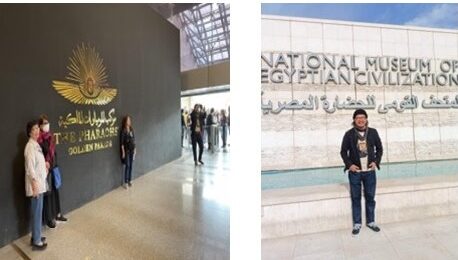
The Pharaohs on Parade are the main event in the Museum but no photos were to be taken. Bro. Eghai Roxas posing in front of the museum.
Finally, as seen in that bus sign ‘coming to the roots’, we have attested all these LEARNING(s) from within: to seek the Holy Spirit that guides us to continuously seek the divine wisdom and knowledge! We now UNDERSTAND OUR FAITH in the triumphant God, as we apply them into our lives and real life experiences.
To God Be the Glory!
Edited by: Sis Vera I. Tuplano, Baruch Ministry